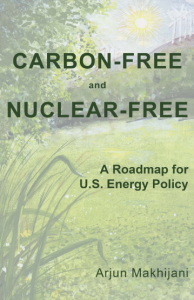
Carbon-Free and Nuclear-Free: A Roadmap for U.S. Energy Policy
By Arjun Makhijani
A joint project of the Nuclear Policy Research Institute (NPRI) and the Institute for Energy and Environmental Research (IEER)
IEER Press, (3rd ed. 2010)
257 pages, paperback
Executive Summary | Four page summary | Slideshow summary | May 2009 Presentation | Science for Democratic Action Vol. 15 No. 1 | Book Flyer
Press Releases and Media Advisories
July 2007 | December 2007 | March 2008 | December 2008
Get the Book
- Download a PDF of the book (it is a large file)
- You can also order a copy of the book ($19.95) by contacting IEER or online via PayPal: ($29.95 for addresses outside of the U.S., Canada, and Mexico, contact IEER for international orders)
Why Carbon-Free and Nuclear-Free?
A three-fold global energy crisis has emerged since the 1970s; it is now acute on all fronts.
- Severe climate change, caused mainly by emissions of carbon dioxide from fossil fuel burning and associated emissions of other greenhouse gases;
- The security of oil supplies, given the political and military turmoil in much of the oil exporting world, centered in the Persian Gulf region;
- Nuclear weapons proliferation and its potential connections to the spread of nuclear energy to address climate change.
These issues are intimately connected. Oil is a leading source of global and U.S. carbon dioxide (CO2) emissions as well as a principal source of local air pollution, and often the main one in cities. Concerns about the insecurity of
oil supply are not new – they were expressed as long ago as 1952 by the Paley Commission, when the United States was just turning from an oil exporter to an oil importer. To complicate matters, many, including some environmentalists,
now propose that nuclear power should be one of the sources of energy used to reduce carbon dioxide emissions. The U.S. energy legislation of 2005 provides significant subsidies, not only for renewable energy sources, but also for new nuclear power plants. But nuclear power and nuclear weapons proliferation are quite entangled with one another.
This report is not about the tangle of these difficult problems, but about a central, indeed indispensable, part of the solution – greatly reducing U.S. emissions from fossil fuel burning, which constituted 84 percent of U.S. greenhouse gas emissions in 2004. Its focus is to assess the feasibility of a zero-CO2 economy in the United States and to lay out a roadmap to achieve that as early as is technically and economically practical, without resort to nuclear power.

A representation of the components that would comprise a Carbon-Free and Nuclear-Free electricity system. Source: IEER